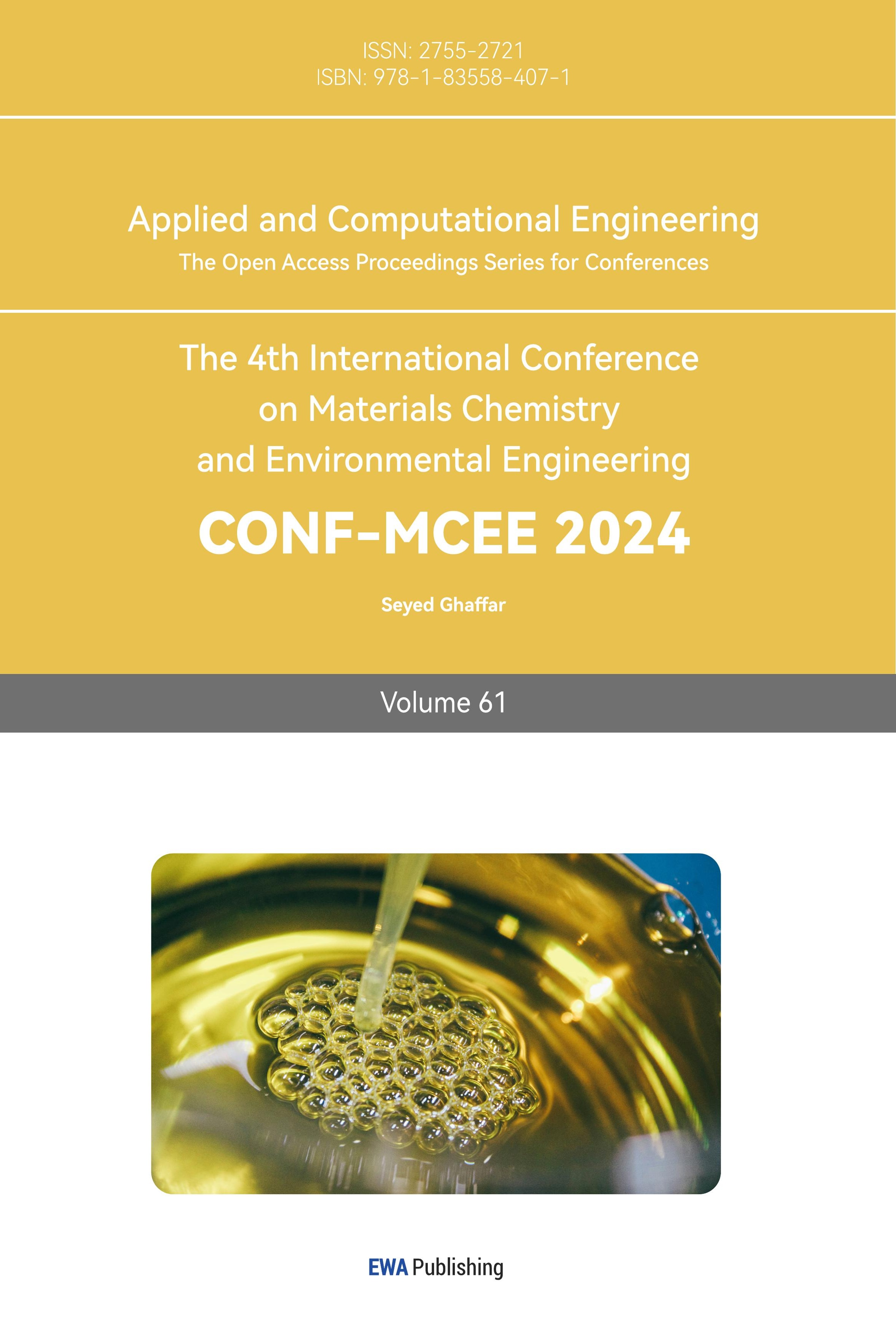1. Introduction
With the development of society and the continuous improvement of people’s living standards, the enhancement of living conditions has become a focal point of concern. Traditional buildings primarily employ conventional construction materials. In the production processes of these materials, not only is energy consumption high, and resource depletion substantial, but irreversible environmental impacts are also generated. Environmental destruction and severe pollution have become significant challenges faced by the building materials production industry. The utilization of green and ecological building materials has become a universally pursued goal and direction in the construction industry.
Currently, the establishment of a resource-efficient and environmentally friendly society has become a consensus among people. Placing high importance on energy conservation, emissions reduction, and achieving sustainable development has also become a shared responsibility throughout society. The term “low-carbon economy” frequently appears in the media and has become mainstream in society. Producers, consumers, and builders all have elevated expectations for construction materials. Safety, health, and environmental protection have become common goals. Adopting clean production technologies and utilizing non-polluting, non-radioactive, and economically eco-friendly building materials not only benefits human health but also contributes to environmental protection. The use of green ecological building materials and the construction of environmentally friendly buildings can effectively prevent environmental pollution. Furthermore, the adoption of renewable, green, energy-efficient, ecological, and environmentally friendly green building materials can significantly improve the severe situation of resource scarcity, conserve resources, achieve waste recycling, and hold essential significance for the construction of a resource-circular society and the implementation of energy conservation and emissions reduction strategies.
2. Green Building and Green Building Materials
Green building refers to the maximization of resource conservation throughout the entire life cycle of a building. This includes energy, land, water, and material conservation, aiming to achieve environmental protection and pollution reduction goals. Green buildings provide people with healthy, adaptable, and efficient use spaces, realizing a harmonious coexistence between humans and nature in construction [1]. Green building materials, also known as ecological building materials, employ clean production technologies, utilize a significant amount of solid waste, minimize the use of natural resources and energy, and produce non-toxic, non-polluting, and non-radioactive products. These materials possess functions for environmental purification and restoration, are recyclable, and effectively contribute to environmental protection and human health. Green building materials exhibit clear advantages, primarily in:
2.1. Low Consumption:
Green building materials utilize a large amount of waste such as slag and garbage in the production process, effectively reducing the consumption of natural resources.
2.2. Low Energy Consumption:
Through the improvement of traditional production processes and technologies, the energy utilization rate is continually increased, actively employing scientific methods to effectively reduce energy consumption.
2.3. Non-Polluting:
In the production and research processes, a large amount of environmentally friendly raw materials is used, and harmful substances are not added, reducing environmental pollution.
2.4. Multifunctional:
Green building material products are characterized by multiple functions and high cost-effectiveness. They possess features such as energy conservation, environmental protection, safety, health, and durability, playing a positive role in improving the ecological environment and enhancing people’s quality of life.
3. Application of Green Building Materials in the Renovation of the Expert Reception Center
During the transformation of the tube tower from the 1950s into an expert reception center, there was an active exploration of using various green building materials to rejuvenate the building. The main structure of the building is brick-concrete, with prefabricated floor slabs inside. The roof incorporates some wooden structures, and the external walls lack insulation materials. The construction utilized solid bricks in a “one up, one down” pattern, with the solid brick specifications being 240mm×115mm×53mm. The original building mainly used clay solid bricks, ordinary silicate cement, and some solid wood. These building materials have several shortcomings. Compared to clay solid bricks, they are mainly made from loess, causing adverse effects on farmland. The production process involves significant energy consumption, and the small size of the building blocks leads to low construction efficiency. Additionally, the substantial weight of solid bricks contributes to poor seismic resistance. Although ordinary Portland cement exhibits high strength and good frost resistance, it lacks resistance to corrosion and heat, with a high heat of hydration. In the current renovation design, the intention is to experiment with the use of green building materials in six aspects: building doors and windows, energy-saving glass, building walls, building insulation materials, decorative materials, and wood structural materials. This aims to further enhance the performance of the renovated building. The exterior of the tube tower is illustrated in Figure 1.
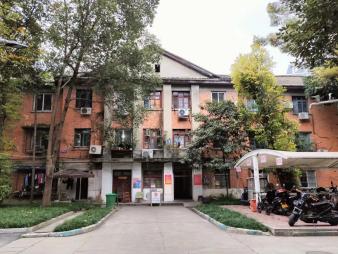
Figure 1. Appearance of the tube tower
3.1. Building Doors and Windows
Doors and windows constitute the fundamental units of a building, and several green building materials can be chosen for these components. The first option is green vacuum glass. This type of glass maximizes sunlight utilization, regulates the internal temperature of the building, and has significant energy-saving, soundproofing, and insulation effects, meeting the requirements for service life. The second option is tempered glass. Tempered glass exhibits excellent thermal and sound insulation, has a long service life, and good corrosion resistance, making it an excellent new composite material. The third option is energy-efficient windows. By using double-layer glass with several layers of BOPET film as the heat insulation layer evenly arranged between the two layers of glass, supporting the separation layer space, it achieves heat insulation and insulation effects, with excellent perimeter sealing. The sealing of doors and windows is crucial, and polyurethane sealant is generally used for sealing. This solvent-free sealant is commonly used in the construction of mid-to-high-rise prefabricated components. It has low volatile odor, high tensile strength, great mechanical strength, excellent elasticity, good wear resistance, cold resistance, weather resistance, adhesion, and recovery. It can resist biological aging and weathering, exhibits good flexibility at low temperatures, does not corrode the substrate, and does not cause permeation pollution. It has good oil resistance and is reasonably priced. The surface can be painted and polished, adhering to various materials. Its performance can be widely adjusted, suitable for dynamic joints. However, polyurethane sealant is not suitable for long-term high-temperature resistance, and its resistance to alkaline water is poor. The use of polyurethane sealant can improve the glass and frame joints, make the joints tighter, reduce air circulation, and achieve energy-saving, environmentally friendly, and green building functional performance [2].
3.2. Energy-Saving Glass
Energy-saving glass is a type of green energy-saving material with excellent anti-radiation effects. Common types include Low-E coated glass, which is heat-resistant, has low radiation, high light transmittance, and features a composite sunlight control function, exhibiting outstanding green performance. During high summer temperatures, it reflects external heat radiation, reducing indoor temperatures. In colder winters, it effectively preserves indoor heat, preventing temperature loss and reducing the energy consumption required for heating. Additionally, Low-E coated glass can effectively prevent UV-rich sunlight from directly entering the interior, damaging indoor furniture. It also avoids the emission of toxic substances in high-temperature conditions. The coating is not prone to dust accumulation, making it easy to clean and protecting windows from the harm of sand and gravel. Refer to Figure 2 for Low-E coated glass.
3.3. Building Walls
One commonly used novel wall material is environmentally friendly flame-retardant honeycomb composite wall material. This is a new building material formed by mixing and compressing renewable energy sources, coal slag, cement, waste, rice straw, and other binders. It effectively reduces waste emissions, rationalizes waste utilization, minimizes the use of cement and steel bars, has low energy consumption, and is lightweight. This green building material is being widely promoted in the construction industry. Simultaneously, construction workers are required to master some new construction techniques [3].
3.4. Building Insulation Materials
Green building materials have found extensive application in wall insulation projects. The most commonly used material is polyurethane insulation board, which is primarily composed of rigid polyurethane and exhibits excellent thermal insulation properties. It can reduce the thickness of the building’s external structure, increasing the interior usable area. Polyurethane materials adopt a closed-cell structure, providing resistance to freeze-thaw cycles, sound absorption, and good insulation. The polyurethane insulation board has strong adaptability, crack resistance, and deformation resistance, effectively ensuring the overall stability and durability of the building. Furthermore, it has a long service life, strong durability, and excellent waterproof performance. When selecting polyurethane insulation boards, it is recommended to consider their characteristics. Polyurethane foam boards are commonly used in external wall insulation systems, serving as an environmentally friendly organic insulation material with high chemical stability, acid and alkali resistance, heat resistance, and no harmful gas emissions, causing no environmental impact. Its various components exhibit good chemical and physical stability, contributing to its environmental performance.
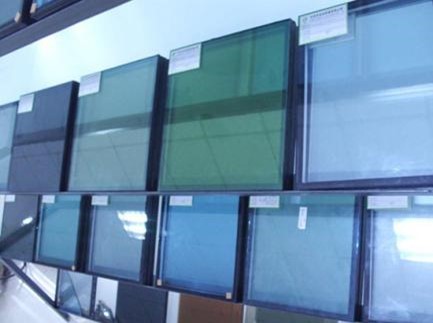
Figure 2. Low-E coated glass
During the construction process using green building materials, to improve wall insulation performance, special materials need to be added as technical aids. For example, glass microbead materials, latex powder polystyrene particle insulation materials, etc. [4].
Glass microbeads are mineral raw materials with a glassy texture. After high-temperature treatment and grinding, they become a lightweight powdery substance. When mixed with cement, they can effectively enhance the thermal insulation and flame retardancy of the cement. Glass microbeads have a rigid appearance, a granular shape, stable structure, and high hardness, making them one of the main components of green cement materials. This can avoid environmental pollution and the production of harmful substances. In winter, people in northern regions like to use “kang” (a traditional heated bed) for warmth. Using green building cement with added glass microbeads can prevent the emission of harmful gases from the wall structure under high-temperature conditions, providing residents with comfort and peace of mind.
Redispersible latex powder is a white powder solid that dissolves easily in water. After dissolving in water, it exhibits increased viscosity, forming a latex. After solidifying, it exhibits good waterproof performance. When applied to the wall insulation project on the external wall surface, it can extend the wall’s service life, enhance corrosion resistance, and insulation. In cases where the wall surface is prone to cracking, excessive cracking may reduce the wall’s insulation performance, affecting the safety and stability of the wall structure. Filling cracks with a mixture of latex and cement mortar can significantly improve the wall’s crack resistance and stability.
3.5. Interior Decoration Materials
Formaldehyde, commonly found in traditional decoration materials, poses significant harm to human health. Therefore, the selection of decoration materials must be approached with caution, prioritizing non-toxic materials and understanding the main components and production processes. Compared to traditional decoration materials, green decoration materials are more environmentally friendly, energy-efficient, and can significantly enhance building energy-saving effects. Typically, materials such as photocatalytic decorative materials and diatom mud wall paint are emphasized.
Photocatalytic materials, as emerging green building materials, can generate functions similar to photosynthesis, effectively degrading and absorbing toxic and harmful gases, achieving sterilization, catalysis, and degradation effects. Photocatalysts refer to semiconductor materials, typically represented by nano titanium dioxide, with photocatalytic functions. They can produce strong oxidizing substances (such as hydroxyl radicals, oxygen, etc.) under light exposure and can be used to decompose organic compounds, some inorganic compounds, bacteria, and viruses. Photocatalysts are the safest and cleanest environmental purification materials currently available, effectively degrading pollutants, enhancing disinfection performance, and decomposing and harmlessly treating toxins released by bacteria or fungi. Photocatalysts are non-toxic, harmless, not easily peeled, resistant to changes, and can continuously purify pollutants under light exposure, demonstrating advantages such as long-lasting and sustained action. Currently, photocatalytic materials have been applied in special construction projects such as medical institutions, widely used in Europe, America, Japan, South Korea, and are expected to further popularize and promote in the future.
Diatom mud wall paint is a novel environmentally friendly wall decoration material that can both decorate interior walls and purify the air. It has the following advantages: first, it is environmentally friendly; Diatom mud wall paint does not contain harmful substances and does not release harmful gases, causing no pollution to both humans and the environment. Second, air purification; Diatom mud wall paint has strong adsorption capabilities for harmful gases and odors, purifying the air and improving indoor air quality. Third, good humidity regulation; Diatom mud wall paint has the effect of regulating indoor humidity and temperature, does not generate static electricity, and is suitable for dry northern regions. Fourth, water resistance and durability; the raw materials used in diatom mud wall paint are inorganic materials, with anti-aging and anti-oxidation properties, not afraid of water, non-peeling, non-cracking, and possessing excellent durability. Fifth, rich and diverse colors; Diatom mud wall paint comes in a variety of types and styles, catering to different decorative preferences [5]. Refer to Figure 3 for diatom mud wall paint.
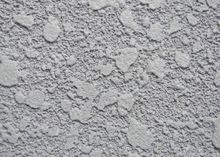
Figure 3. Diatom mud wall paint
Diatom mud products, with their unique “molecular sieve” structure, create a purification feast for us. With its powerful adsorption and ion exchange capabilities, it absorbs harmful substances in the air, cleverly eliminates various unpleasant odors, and makes the indoor air fresh and pleasant. Diatom mud excels in noise reduction, effectively improving the sleep environment and enhancing sleep quality. In the event of a fire, it exhibits flame-retardant properties, producing no harmful smoke, providing us with a sense of security in our living spaces. The magic of diatom mud is further demonstrated as it automatically adjusts indoor air humidity with temperature changes, maintaining environmental humidity at a relative balance. During hot summers, it can absorb excess moisture, while in cold winters, it releases stored water, keeping the indoor environment humid. The main component of diatom mud, diatomite, has a low thermal conductivity, making it an ideal thermal insulation material. Its thermal insulation effect is six times that of an equivalent thickness of cement mortar, acting as an efficient thermal barrier, providing a comfortable temperature for living spaces. Additionally, diatom mud is free of heavy metals, does not generate static electricity, and its walls are less prone to dust accumulation, remaining durable and fresh. When moisture contacts the wall surface, it produces a “waterfall effect,” continuously releasing negative oxygen ions, which are beneficial to the human body. In terms of color, diatom mud uses inorganic mineral pigments for coloring, resulting in soft, natural hues that are long-lasting and resistant to visual fatigue. Its natural, pollution-free characteristics, combined with easy repairability, make it an ideal choice unmatched by traditional coatings such as latex paint and wallpaper. Of course, diatom mud has its limitations. Due to its higher production cost, the price is relatively expensive; it also demands high construction requirements, necessitating professional, systematically trained construction workers with practical painting experience. Moreover, diatom mud is not suitable for wet wiping and is not recommended for areas exposed to water, such as bathrooms and kitchens. Overall, with its unique environmental functions and superior performance, diatom mud brings a fresh breath and comfortable experience to our living spaces. However, in the process of selection and use, factors such as price and construction requirements should be considered.
3.6. Wood Structural Materials
Cross-Laminated Timber (CLT), a type of glued laminated wood, is a new quality timber that was initially utilized in Europe and has gained increasing attention worldwide in recent years. It can be used in the construction of residential, commercial, and infrastructure buildings. CLT is typically composed of 3-9 layers of odd-numbered wood boards, staggered at a 90-degree angle in the wood grain direction. The material possesses both the texture and feel of wood and the strength of reinforced concrete, with an inherently low carbon footprint, meeting the demands of reducing carbon emissions in contemporary architectural practices. Currently, numerous multi-story buildings entirely constructed from CLT have been built in Europe and North America. Design specifications related to wood construction are continuously being refined to explore the potential applications of this new material in construction and energy conservation. The advantages of this material include preventing deformation and cracking by using dry wood, reducing vibration, allowing flexible decoration, and meeting the requirements for beams of different sizes, spans, cross-sections, and shapes with good anti-corrosion and anti-insect effects. Refer to Figure 4 for glued laminated wood.
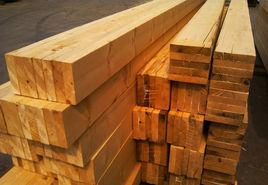
Figure 4. Plywood
4. Conclusion
The widespread application of new environmentally friendly building materials, the development of green building materials, and the construction of green and energy-efficient buildings have become an inevitable trend in social development. The production and use of green building materials can effectively reduce environmental pollution. The use of renewable or recyclable green materials can minimize environmental degradation. Green building materials exhibit excellent insulation and thermal insulation properties, contributing to a significant reduction in building energy consumption and achieving energy-saving effects. These materials do not emit harmful gases, posing no harm to human health, thereby enhancing people’s quality of life. Although the initial investment in green building materials may be high, in the long run, due to their energy-saving and durable characteristics, substantial savings can be realized in maintenance and replacement costs, resulting in significant economic benefits. The development and utilization of green building materials align with the concept of sustainable development, contributing to environmental protection and resource conservation, thus creating a better living environment for humanity. Vigorous promotion and application of green building materials are of paramount significance for the establishment of a resource-efficient society.
References
[1]. Ren, Y. J. (2023). Application Status and Development Trends of New Green Building Materials. Foshan Ceramics, 33(11), 105-107.
[2]. Wen, J. M. (2021). Development and Application of Green Building Materials. In Proceedings of the Annual Academic Conference and First Chief Engineer Forum of the China Civil Engineering Society. Hunan Construction Engineering Group Co., Ltd., 3, DOI: 10.26914/c.crankily.2021.065643.
[3]. Zhang, G. L. (2023). An Analysis of the Development and Application of Green Building Materials. Living Spaces, (13), 83-85.
[4]. Fan, Y. Z. (2023). Application of Green Building Materials in Wall Insulation Engineering. Living Spaces, (07), 50-52.
[5]. Zhao, F. (2023). Exploring the Development Trends of Architectural Design under the Concept of New Materials and Technologies in Green Building. Living Spaces, (22), 98-100.
Cite this article
Zheng,Y. (2024). A discussion on the application of green building materials in the renovation of buildings. Applied and Computational Engineering,61,292-298.
Data availability
The datasets used and/or analyzed during the current study will be available from the authors upon reasonable request.
Disclaimer/Publisher's Note
The statements, opinions and data contained in all publications are solely those of the individual author(s) and contributor(s) and not of EWA Publishing and/or the editor(s). EWA Publishing and/or the editor(s) disclaim responsibility for any injury to people or property resulting from any ideas, methods, instructions or products referred to in the content.
About volume
Volume title: Proceedings of the 4th International Conference on Materials Chemistry and Environmental Engineering
© 2024 by the author(s). Licensee EWA Publishing, Oxford, UK. This article is an open access article distributed under the terms and
conditions of the Creative Commons Attribution (CC BY) license. Authors who
publish this series agree to the following terms:
1. Authors retain copyright and grant the series right of first publication with the work simultaneously licensed under a Creative Commons
Attribution License that allows others to share the work with an acknowledgment of the work's authorship and initial publication in this
series.
2. Authors are able to enter into separate, additional contractual arrangements for the non-exclusive distribution of the series's published
version of the work (e.g., post it to an institutional repository or publish it in a book), with an acknowledgment of its initial
publication in this series.
3. Authors are permitted and encouraged to post their work online (e.g., in institutional repositories or on their website) prior to and
during the submission process, as it can lead to productive exchanges, as well as earlier and greater citation of published work (See
Open access policy for details).
References
[1]. Ren, Y. J. (2023). Application Status and Development Trends of New Green Building Materials. Foshan Ceramics, 33(11), 105-107.
[2]. Wen, J. M. (2021). Development and Application of Green Building Materials. In Proceedings of the Annual Academic Conference and First Chief Engineer Forum of the China Civil Engineering Society. Hunan Construction Engineering Group Co., Ltd., 3, DOI: 10.26914/c.crankily.2021.065643.
[3]. Zhang, G. L. (2023). An Analysis of the Development and Application of Green Building Materials. Living Spaces, (13), 83-85.
[4]. Fan, Y. Z. (2023). Application of Green Building Materials in Wall Insulation Engineering. Living Spaces, (07), 50-52.
[5]. Zhao, F. (2023). Exploring the Development Trends of Architectural Design under the Concept of New Materials and Technologies in Green Building. Living Spaces, (22), 98-100.





